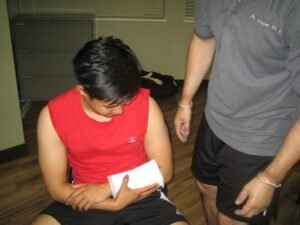When it comes to bleeding, there are first aid measures that you have to perform to stop the flow of blood on cuts and a nosebleed.
Scrapes, cuts and puncture wounds
Once the skin is scraped or cut, the injured area will start to bleed since the blood vessels are damaged. Bleeding basically has a useful function since it helps clean out the wound. On the other hand, excessive bleeding can lead to shock. In most cases, you could not always judge how serious a particular wound is by the amount of blood. Some injuries that are considered serious tend to bleed a little. Cuts on the face, head and mouth usually bleed a lot since there are many blood vessels in the areas.

Wounds on the chest and abdomen can be serious due to the possibility that the internal organs are damaged, resulting to internal bleeding and eventually shock. Chest and abdominal wounds are considered as medical emergencies and you have to call for emergency assistance right away, especially if the symptoms of shock are present such as weakness, dizziness, pale skin, increased heart rate and shortness of breath. While waiting for the medical team to arrive, you have to provide first aid for shock. All you have to do is to position the individual in a lying position with the feet elevated up to 12 inches. Cover him/her with a blanket to keep the body warm.
First aid for cuts and wounds
1. Try to calm the individual. In case the cut is large and bleeding profusely, put him/her in lying position. If the wound is on the leg or arm, the limb must be raised above the heart level to slow down the bleeding.
2. Take away any debris present. If an object is embedded in the body, do not attempt to remove it.
3. For small cuts, it should be washed with water and soap. Avoid washing large wounds.
4. Using a bandage or cloth, apply pressure on the wound for about 10 minutes. In case the blood soaks through, simply add another bandage or cloth and continue to hold pressure for another 10 minutes.
5. Once the bleeding is controlled, tape a clean bandage over the cut.
When to seek emergency assistance for a cut
• If the cut or wound is deep or jagged or it is a puncture wound
• Caused by an animal
• Cut is on the face
• Bleeding could not be controlled
• There is dirt or debris that could not be removed after washing
First aid for a bloody nose
1. Allow the individual to sit down, leaning the head forward. This will minimize pressure in the nasal veins, thus slowing down the bleeding.
2. Push the nostril firmly on the septum on the side of the nosebleed. Hold for 5-10 minutes.
3. Once the flow of blood stops, instruct the individual not to blow his/her nose for several days. Blowing the nose can dislodge the clot and cause bleeding to start again.
By knowing how to deliver the appropriate first aid measure for cuts and a bloody nose, you can easily help out any family member, friend or colleague at work.
